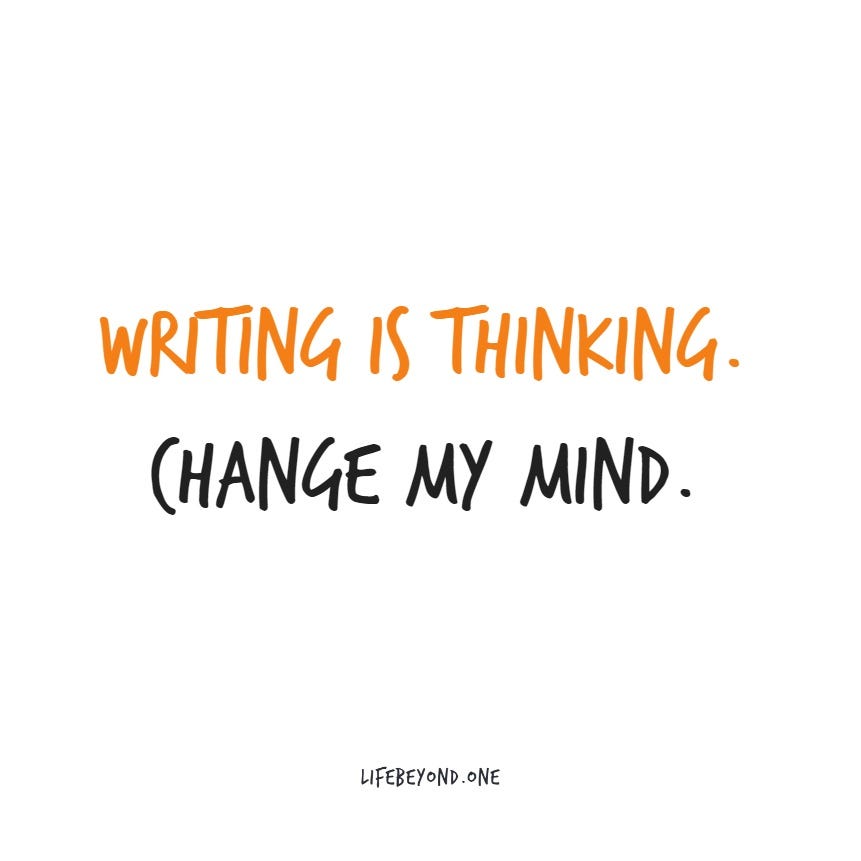Improve Your Writing By Understanding These 6 Simple & Timeless Principles
#1: Good writing is that which helps you and your readers reach your respective goals

One of the best ways to improve your knowledge and understanding of something is to try to teach other people about that thing. I promise you.
Some thoughts about this noble art and science of writing came up as I was discussing the desired working of the main functionality for the A.I. startup StoryLab.ai that I’m helping build.
I’d like to share with you the insights that came to me. Which started with the following, innocent-looking open question I asked myself:
‘What constitutes a good headline?’
Which then morphed into ‘what is the goal of a headline?’ — through the realization that a ‘good’ headline is only as good as the level to which it attains the goal that the writer had in writing it.
You can imagine that took me on a spinning head tour of my own thoughts on writing — which I have been building up over a career of 10+ years as a copywriter, content strategist, brand storyteller, and teacher of writing.
Here’s me, rewriting the first draft of this article at 1:24 AM.
Here’s what I came up with, I hope it will help you tell more effective stories as well — and to do it more easily. Or otherwise, improve your thinking about writing. Or maybe all of the above.
Let’s see.
0. What constitutes good writing?
Let’s start at ground zero.
To get ‘better’ at a thing we need to know what constitutes being ‘good’ at that thing. But then there is no one ‘right’ way to do writing, is there? I’ll give you a few examples of what I mean by that.
A poem may trigger someone to treat their spouse better. A piece of sales content may lead someone to completely rethink the way they were priorly attacking a given problem they faced at work.
An angry email may make someone laugh, or delight another reader on the merit of its literary style.
Were these pieces of writing ‘good’?
Whether or not a piece of writing is good, all depends on the goal we have for that given piece, and the degree to which that piece or story helped us reach that goal.
Good writing is not necessarily pretty. Or grammatically perfect. Or instantly profitable.
At the same time, there are some things that apply as goals for writing, regardless of the specifics of the situation at hand, our micro-goals in the moment, or the blank page staring us in the face.
1. What is the purpose of writing?
The purpose or goal of writing is to organize your thoughts and feelings around a given subject in such a way that they become clearer to you, and can be clearly conveyed to someone else.
The goal of that conveying, in turn, is that you ultimately inspire, convince and/or help someone change something in their opinions, attitudes or knowledge, which leads to changed behavior.
That change in behavior then having again as its ultimate goal to help that person get closer to achieving their goals — and often at the same time helping that person help you achieve your goals.

Change my mind. No, literally, if you think differently about this, add a comment. I’d love to improve my thinking.
Now, mind you — these goals of yours and your readers do not have to be self-centered goals. By no means. Your goal could be for more ladies to have a better sense of self-worth. Or for less people to throw plastic garbage in the streets or out in nature. Or for someone to go support a specific charity that you care deeply about.
My reasoning is that 99% of the time when people communicate, it’s to coordinate. It’s to find ways to combine and connect our goals and needs, and our knowledge and skills to those of another. And/or, we need to feel emotionally connected.
Also, 99% of the time our goal will have something to do with growth, or — put in another way — improvement, of some aspect of our lives, our business or our work, or ourselves.
My reasoning is also that 99% of the time, to achieve our growth or improvement goals, we need the help of someone else and/or we need to find someone who will let us help them. We need to connect.
The purpose or overarching goal of writing is to organize your thoughts and feelings. So they can be conveyed to help you connect to another human. So you and the other human can get closer to your goals.
Change my mind. Seriously.
2. Then what is the goal of the headline?
The goal of the headline then is, indeed, as many writing coaches put it, to ‘grab attention’. But it goes a little bit deeper than that.
The goal of a headline is not simply to get the most possible clicks.
For you, in the most basic and egocentric way, the headline is there just to grab your reader’s attention and get the most views and the best chances of the most people actually reading your stuff. Ok.
But for the reader, the headline is actually to signal to them that this piece of work has the answers they are looking for. That this is relevant to them. That this will help them.
So ultimately, the purpose of the headline is to make the first connection between your need to connect with the right people to achieve your goals, and the right people’s need to connect with you, to reach theirs.
The way to do that is — either before or after you’ve written the actual piece — to summarize the main thought you want to convey about the subject you’re writing about.
In such a way that it elicits the emotion that is attached to your thoughts — in favor of a sense of urgency and propensity to act, to click, and read. And in such a way that it clearly hints at but doesn’t give away entirely what your main thought on the matter is.
Another goal of your headline is to make a promise: ‘this will give you value’ — and to force you to make good on that promise with what you write.
3. What is the purpose of the intro or hook?
The purpose of the intro or hook is a variety of things.
The hook is there to set the tone. It’s also there to signal to your reader that this is indeed about the subject that the headline promised it would be, and from such a perspective that this piece will indeed be helpful to them.
And it’s a signal to your reader that the style and tone of this piece is going to be for them, or not.
Your hook or intro may of course be one sentence long, or it may be longer — but either way, it serves as a writing prompt for you, and a reading prompt for your reader. It’s often an emotional validation — with the hook often designed to set the tone emotionally, and to palpably illustrate the problem the writer is about to tackle.
4. What is the purpose of the three main paragraphs or sections of your story?
The three — or more, but I prefer three — main paragraphs or sections of your story, in the middle between your hook and your conclusion and CTA — are the way you build up your main thought.
These three can form a story with a beginning, a middle and an end. And they may follow the structure of laying out the problem, proposing or explaining the solution, and then recounting the results after the proposed or implemented solution will be or was actually implemented.
The purpose of your three main paragraphs is to explain and ground your main thought about the subject you’re writing about. In a logical following order, where each line and each paragraph builds on the one preceding it.
5. What is the purpose of the conclusion and/or CTA?
The purpose of the last part of your article is to drive your point home, and to invite the reader — in case he or she has been inspired, convinced, or helped by what you gave them — to act in such a way that they get closer to reaching their goals, while simultaneously getting you closer to your goals.
Now, remember — these goals of yours and your readers do not have to be self-centered goals.
Your goal in writing this piece has been to change someone’s thinking, attitudes, or knowledge about something in such a way as to change something in their behavior. Your conclusion is the place where you summarize your main thought, that you have been building up to, and that might finally end up changing what you wanted to change.
Your Call-to-Action then, is giving your reader a clear invitation to take the first step towards their desired end. And yours.
Stretch your back and walk up straight.
Recycle that plastic bottle.
Donate to this amazing charity, here.
Get in touch and let me know how I can help you write better stories, here.

Go write more effective stories yourself. Write more. Write better. Grow faster. Learn more about how to do that at StoryLab.ai.
